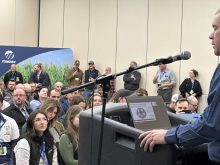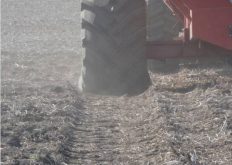With the advent of mechanized agriculture, farms became a great deal more productive than they were in times past. However, the large machines that ply farmers’ fields today can be hard on the soil and cause issues with compaction.
Our cover story of this issue of Grainews provides some suggestions for preventing or reducing soil compaction. On the flip side, here are some common mistakes that can make the problem worse.
Don’t criss-cross
Marla Riekman, a soil management specialist with Manitoba Agriculture and Resource Development, says one way soil compaction can increase in the fall is if there are multiple pieces of harvest equipment moving in several different directions.
Read Also

Claas brings 1000 Series SP forage harvesters to Canada
In mid-August, Claas unveiled its new line of Jaguar forage harvesters at an event in Visalia, California, deep in the heart of that state’s dairy region.
Rather than follow the course of a combine, for example, a loaded grain cart may cut across the field in a perpendicular path to get to a waiting semi. This criss-cross action means there’s more area within the field that’s getting compacted.
“That’s why we often talk about compaction during harvest time as being more of an issue,” says Riekman. She recommends producers limit random field traffic as much as they can during harvest or for any other operation to try to minimize compaction caused by equipment.
Riekman says as one strategy, grain carts could travel along the headlands, then turn up and follow the tracks of the last combine pass. Once the grain cart reaches the combine, it could pull out, get filled up, and then retrace its route along the combine tracks. “It means a little bit more travel time, but it could have a big benefit on the field.”
Don’t over-inflate tires
Riekman says it’s essential for farmers to keep an eye on their tires when operating field equipment because overinflated tires exert more ground pressure and cause more compaction as a result.
“Running tires at above their rated pressure for field activity is a bad thing, so you always want to make sure that you know what your proper inflation rate for field activity should be for the tire,” she says.
If producers don’t know what the proper rate is, Riekman suggests they try contacting the equipment or tire manufacturer to get the information.
Don’t overuse equipment
Plow pans are one type of soil compaction formed with the repeated use of tillage equipment. The move to no-till production systems has meant they are less of a concern, but Riekman says a newer practice can also cause compaction problems if it’s done frequently enough.
Riekman says with excessive use, the high-speed shallow discs or vertical till units that are growing more popular in the Prairies can create plow pan layers only a couple of inches deep. To help keep that from happening, she recommends producers try not to use the same piece of tillage equipment all the time on the same field, and instead rotate it with other implements if they can.















